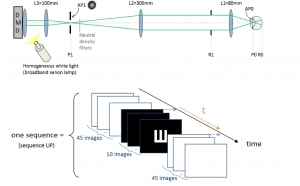
Autors: Lucie Sawides, Adrián Gambín-Regadera, Alberto de Castro, and Pablo Artal
Journal: Biomedical Optics Express
Volume: 9(6)
Pages: 2640-2647
Year: 2018
ISBN: 2156-7085
Abstract
How brief can a visual stimulus be and still be seen? To answer this question, we developed a digital micromirror device (DMD) based system operating at high speed (22.7 kHz) to control the rapid presentation of visual stimuli and estimated the minimum time required to identify the orientation of tumbling Snellen E letters. Time thresholds were measured in five subjects using a QUEST algorithm to vary the presentation time of the letters subtending either 0.75°, 1.5° and 4.5° on the retina, for two different effective pupil sizes (0.3 and 1 mm). Additionally, to evaluate the effect of defocus on time thresholds, the experiment was repeated with 1.5° letters and induced myopic defocus with 3, 6 and 9 D trial lenses placed in a conjugated pupil plane. We found that subjects were able to identify the orientation of the letters presented as briefly as 5 ms.
Download PDF: High speed visual stimuli generator to estimate the minimum presentation time required for an orientation discrimination task
